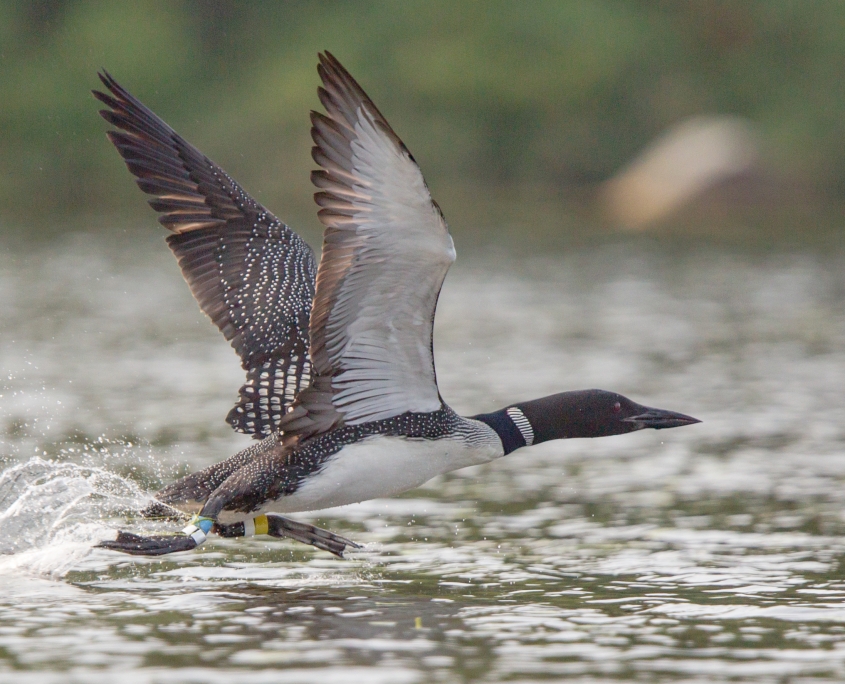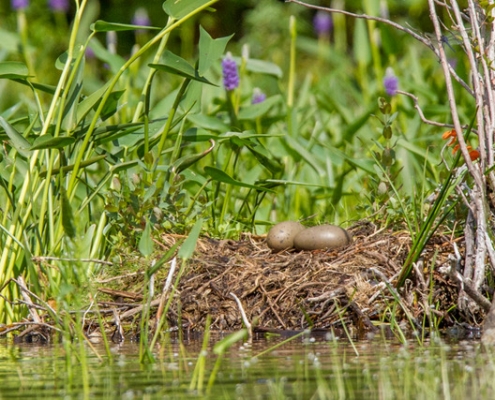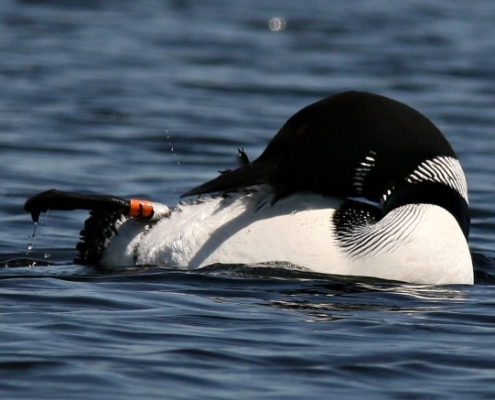Banding and Tracking Loons
LPC biologists band loons on lakes throughout New Hampshire, which allows us to identify and track individual loons to investigate aspects of their life history such as life span, age at first breeding, fidelity to mates and breeding territories, and the relationships between their breeding and wintering grounds. The capture of loons for banding also allows the collection of blood and feather samples for analysis of toxic contaminants, stress-indicating hormones, genetic markers, blood parasites, and other disease-causing organisms. Resightings of banded loons on the ocean have revealed that at least some of New Hampshire’s loons winter off the Atlantic coast from Maine to Rhode Island, and so remain in New England year-round.
Causes of Mortality
One of the best ways to discover the challenges facing New Hampshire’s loon population is to determine causes of mortality of individual birds. Since 1975, LPC has collected dead loons found by the public, LPC volunteers, and LPC field staff. LPC collaborates with veterinarians and wildlife pathologists to perform necropsies (animal autopsies) to help determine the cause of death for each loon that we collect. This has allowed us to identify and begin to address the human-related causes of loon mortality, including lead poisoning from ingested lead fishing tackle, fishing line entanglement, and boat strikes.
Climate Change
New Hampshire’s loons are close to the southern limit of their breeding range. As a northern species, loons breeding at the southernmost extent of their range may be at risk from high breeding season temperatures, which can stress incubating loons. Loons also nest close to the water’s edge, which makes them vulnerable to water level fluctuations that can flood their nests.
National weather service records indicate that the average New Hampshire June-July (loon nesting season) temperature has increased about 2 degrees Fahrenheit and total June-July rainfall has increased more than 2 inches since 1975. LPC has found that loon breeding success, as measured by the number of chicks hatched per nesting loon pair, has declined as temperatures and rainfall have increased in New Hampshire. If further increases in temperatures and rainfall predicted by climate change models are accurate, these and a range of other possible effects of climate change will increasingly challenge New Hampshire’s loons. LPC is studying the effects of increasing temperatures and rainfall on loons and ways in which we can help loons cope with these coming changes.
Contaminants
Loons are long-lived birds at the top of aquatic food webs. Because of this, they are at risk from contaminants that bioaccumulate (increase in concentrations in animals over time) and biomagnify (increase in concentrations as they move up the food web). Every year, LPC collects unviable loon eggs from lakes around the state. We are in the process of using these eggs to examine the relationship between organic contaminants and common loon reproductive success. Tested eggs have been found to contain elevated levels of PBDE’s (flame retardants), PCB’s (industrial cooling agents), dioxins/furans (byproducts of industrial processes), PFOS (stain repellants), and DDT and chlordane (insecticides). In many cases, these contaminants exceeded lowest observed effects levels (levels known to cause measurable declines in health and/or reproductive success) in other fish-eating birds. LPC is continuing to investigate the levels, effects, and sources of these contaminants in loons to determine the threats they pose to individual loons and loon populations.
Click here to read our Egg Contaminant Report.
Click here to read our PFAS Report.
Pathogens
As with all living things, loons are at risk from pathogens (disease-causing organisms). LPC’s banding, blood sampling, loon rescues, and necropsies (animal autopsies) have revealed that loons in New Hampshire are susceptible to fungal diseases like aspergillosis and have been exposed to EEE (Eastern Equine Encephalitis), avian influenza, and, more recently, Plasmodium parasites that cause avian malaria. Some of these pathogens may become more problematic if New Hampshire’s climate becomes warmer and wetter, as predicted in climate change models.






